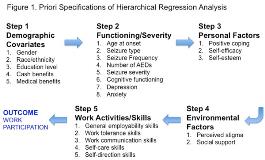Evaluating the WHO ICF Framework as an Employment Model for People with Epilepsy
Abstract number :
3.342
Submission category :
Late Breakers
Year :
2013
Submission ID :
1867673
Source :
www.aesnet.org
Presentation date :
12/7/2013 12:00:00 AM
Published date :
Dec 5, 2013, 06:00 AM
Authors :
C. Sung, J. Jones, F. Chan
Rationale: The employment rate of people with epilepsy is notoriously low and has not changed materially during the last three decades. A thorough understanding of complex person-environment factors and their interaction effects on employment will be needed. The primary goal of this study was to evaluate the World Health Organization s International Classification of Functioning, Disability, and Health (ICF) framework as a multidimensional, comprehensive employment model for people with epilepsy. An additional aim of this study was to investigate the relationship between contextual factors and work participation.Methods: A quantitative descriptive design utilizing hierarchical regression analysis (HRA) and correlational analysis were used in this study. A total of 262 participants were recruited from 23 state affiliates of the Epilepsy Foundation. The dependent variable (DV) investigated in this study was work participation which was measured by the Stage of Change-Work Participation Scale. The independent variables (IV) were composed of the four major components proposed in the ICF framework: (1) body functions and body structures (i.e., seizure severity, cognitive deficits, depression, and anxiety); (2) activities (i.e., abilities/skills specific to work); (3) personal factors (i.e., positive coping, self-efficacy, and self-esteem); and (4) environmental factors (i.e., perceived stigma and social support). The prior specification of the HRA is depicted in Figure 1.Results: Results from the hierarchical regression analysis suggest that demographic variables, disability-related variables, work-related variables, and environmental variables accounted for 55% of the variance in work participation in this study. According to Cohen s (1988) standards for the behavioral sciences, this is considered a large effect size. Social support ( = .12), general employability ( = .22) and work tolerance ( = .50) were positively associated with work participation, whereas medical benefits ( = .09), number of AEDs ( = .11), perceived stigma ( = .28), and work communication ( = .28) were negatively related to work participation (see Figure 2). Follow-up mediator analyses provided support for the partial mediating effect of work-related abilities/skills on the relationships between self-esteem and work participation as well as perceived stigma and work participation.Conclusions: This study contributes new knowledge about the effect of work functioning, personal and environmental factors on work participation of people with epilepsy, providing theoretical guidance and research evidence for developing and validating efficacious, effective, and efficient employment interventions. It further supports the use of the ICF framework that acknowledges the multidimensional interactions of demographic factors (e.g., receipt of medical benefits), physiologic factors (e.g., seizure severity), psychosocial factors (e.g., positive coping strategies), and vocational factors (e.g., work skills/abilities) that can have an impact on symptoms, behaviors, and outcomes (e.g., work participation) of people with epilepsy.
